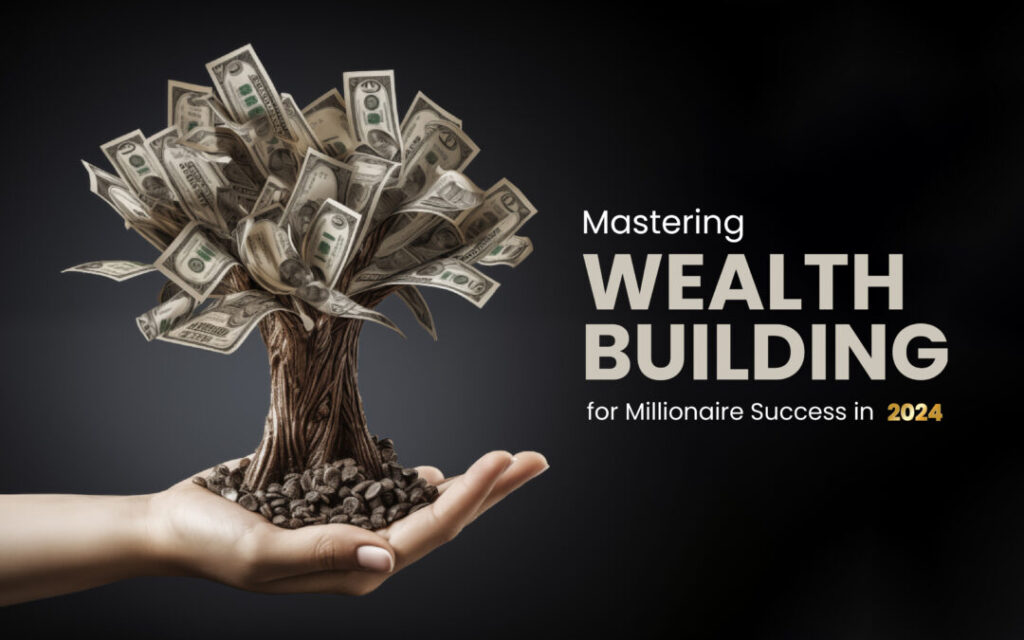7 Wealth-Building Strategies the Rich Use and the Poor Ignore
Wealth doesn’t just happen by chance. The rich follow distinct strategies to build and grow their wealth—strategies that are often overlooked by those who struggle financially. While some may chalk this up to luck or privilege, in reality, many of these strategies are accessible to anyone willing to shift their mindset and adopt different financial habits. Let’s dive into seven wealth-building strategies the rich use, and the poor often ignore.
The Mindset Shift Wealth Starts in the Mind
Before diving into specific strategies, it’s essential to address the number one factor that separates the rich from the poor: mindset. Wealth is not just about how much money you make; it’s also about how you think about money.
Thinking Long-Term vs. Short-Term
One major difference between the wealthy and those who struggle financially is their perspective on time. The rich tend to think in terms of years or even decades, while the poor often focus on immediate needs. This long-term thinking drives better decisions, whether it’s choosing investments or growing a business.
Abundance vs. Scarcity Mentality
An abundance mentality encourages the belief that there’s enough wealth and success for everyone. Those with a scarcity mindset, on the other hand, believe resources are limited, leading them to avoid risks and miss opportunities. The rich operate from an abundance mindset, always seeing potential for growth.
Failure as a Learning Opportunity
The rich don’t fear failure. Instead, they view it as an inevitable part of the learning process. Each failure is a step toward success. The poor often avoid risks because of a fear of failure, limiting their potential.

Strategy 1 Multiple Streams of Income
The wealthy understand that relying on a single source of income is risky. By creating multiple streams of income, they ensure that they are not entirely dependent on one job or investment.
Active vs. Passive Income
Active income is the money you earn from working (like a job), whereas passive income comes from assets that require little ongoing effort, such as rental properties, dividends from stocks, or royalties from digital products.
Examples of Passive Income
Some common passive income sources include real estate investments, stock market dividends, and digital products such as eBooks or online courses. These income streams can grow over time, even while the individual focuses on other pursuits.
How the Rich Diversify Their Income
The wealthy don’t put all their eggs in one basket. They often have a blend of income sources—from businesses and investments to intellectual property rights. This diversification helps reduce risk while multiplying opportunities for wealth growth.
Strategy 2 Investing Early and Consistently
One of the most important strategies for wealth-building is investing early and consistently. The earlier you start, the more time your money has to grow.
The Power of Compound Interest
Compound interest is often called the eighth wonder of the world because it allows your money to grow exponentially over time. Even small investments can lead to significant wealth if you give them enough time.
Why Consistency Matters in Investing
Wealthy individuals don’t try to time the market. Instead, they consistently invest over the long term. This practice, known as dollar-cost averaging, reduces risk and helps smooth out market volatility.
Examples of Early Investments
Stocks, real estate, and mutual funds are common vehicles for early investments. These options, when nurtured over decades, can provide a comfortable cushion of wealth.
Strategy 3 Leveraging Debt Wisely
Debt can be a tool for wealth-building, but only if it’s used wisely. The rich understand the difference between good debt and bad debt.
The Difference Between Good and Bad Debt
Good debt, such as a mortgage on a rental property or a business loan, can generate income. Bad debt, like credit card debt, often leads to more financial strain. The wealthy use good debt to their advantage, leveraging it to invest in income-producing assets.
How the Rich Use Leverage to Their Advantage
The wealthy use leverage—borrowing money to increase their investing capacity—to maximize their returns. For example, they might take out a loan to buy a property, rent it out, and let the rental income cover the loan payments.
Debt Repayment Strategies for the Poor
While the rich use debt strategically, many people fall into the trap of bad debt. Paying off high-interest debt should be a priority before focusing on wealth-building. The snowball method, which focuses on paying off the smallest debts first, is an effective strategy for debt reduction.

Strategy 4 Networking and Building Relationships
It’s not just what you know; it’s who you know. The rich actively build networks of people who can help them achieve their financial goals.
The Value of a Strong Network
A strong network can provide opportunities, knowledge, and support. Whether it’s finding a mentor, securing funding for a business, or accessing investment opportunities, the right connections can open doors.
How the Rich Build Beneficial Connections
The wealthy understand the value of relationships and often invest time and effort into networking. They attend conferences, join elite groups, and stay in touch with people who can influence their financial journey.
Building Relationships with Mentors
Mentorship is a powerful tool for growth. Wealthy individuals often seek out mentors who have achieved the level of success they aspire to. These mentors provide guidance, advice, and sometimes even connections to lucrative opportunities.
Strategy 5 Continuous Learning and Self-Improvement
The rich never stop learning. They invest in their own personal and professional development, knowing that the more they learn, the more they can earn.
The Rich Invest in Themselves
Whether through formal education, online courses, or reading, the wealthy prioritize learning. Personal development is seen as an investment that yields high returns.
Examples of Skills and Knowledge that Drive Wealth
Financial literacy, negotiation, and entrepreneurship are key skills that many wealthy individuals develop. Learning how to manage money invest wisely, and negotiate effectively can significantly impact your ability to build and sustain wealth. Additionally, mastering new technologies, understanding market trends, and continuously upgrading your professional skills are crucial in today’s fast-paced world.
How to Prioritize Learning on a Budget
You don’t need to spend a fortune on education to benefit from continuous learning. Free online courses, affordable books, podcasts, and networking events are accessible ways to improve your knowledge base. Even making time for daily reading or using your commute to listen to educational content can set you on the right path toward financial growth.
Strategy 6 Owning Assets, Not Just Liabilities
One of the key principles of wealth-building is the accumulation of assets rather than liabilities. While liabilities drain your financial resources, assets generate income or appreciate over time, helping you build wealth.
The Importance of Asset Accumulation
The rich focus on acquiring assets that put money in their pockets. This could be anything from real estate that appreciates in value to stocks that pay dividends. The poor, on the other hand, often accumulate liabilities, such as cars or consumer debt, that decrease in value or cost money to maintain.
Examples of Assets vs. Liabilities
- Assets: Real estate, businesses, stocks, bonds, intellectual property
- Liabilities: Cars, electronics, loans, expensive clothing or gadgets
If you’re constantly spending money on things that lose value, you’re accumulating liabilities. The wealthy focus on owning things that grow in value or generate cash flow, positioning them for long-term financial success.
How to Start Building Assets
If you’re starting with little capital, building assets might seem daunting. But you can start small. Begin with investing in stocks or index funds, purchasing rental properties with a mortgage, or even creating digital products that generate passive income. Each small step compounds over time and contributes to a wealth-building portfolio.

Strategy 7 Taking Calculated Risks
While it might seem like the rich are simply lucky, many of them built their wealth by taking calculated risks. They understand that without some level of risk, it’s nearly impossible to experience significant rewards.
Risk vs. Recklessness
The key to taking calculated risks is to differentiate between risk and recklessness. The rich do their homework before taking action. They don’t gamble their wealth away but instead make informed decisions based on research, advice, and an understanding of market conditions.
Why the Rich Are Comfortable with Risk
The wealthy understand that risks, when calculated carefully, can lead to substantial returns. They are comfortable with the idea of losing money in the short term if the long-term outlook is promising. Risk tolerance is an essential component of their success, allowing them to seize opportunities that others may shy away from.
Examples of Calculated Risks Taken by the Wealthy
- Investing in Startups: Many wealthy individuals invest in startups, understanding that while some may fail, those that succeed can bring extraordinary returns.
- Real Estate Development: Buying and developing properties in undervalued areas is another calculated risk that can lead to massive profits.
- Stock Market Investments: The stock market can be volatile, but with the right knowledge and strategy, many rich individuals take the calculated risk of investing in stocks and riding the ups and downs of the market.
Conclusion
Wealth-building is not about luck or simply having a high income; it’s about adopting the right strategies, taking calculated risks, and maintaining a growth-oriented mindset. The rich focus on creating multiple income streams, investing early and consistently, leveraging debt wisely, and continuously learning and improving. They own assets that generate wealth and build strong networks that open doors to new opportunities. By adopting these same principles, anyone can begin their journey toward financial freedom.
Remember, wealth-building is a marathon, not a sprint. It’s about the long game, and the sooner you start, the better positioned you’ll be for future success.
FAQs
How do I start building wealth if I have no money?
Starting with little or no money can feel intimidating, but it’s possible. Begin by improving your financial literacy and focusing on reducing debt if you have any. Start small by saving a portion of your income, even if it’s just a few dollars at a time. Investing in stocks, ETFs, or mutual funds with minimal starting amounts can be an accessible entry into wealth-building. Additionally, consider building a side hustle to increase your income over time.
What is the best age to start investing?
The best time to start investing is as early as possible. The earlier you start, the more time your investments have to grow through the power of compound interest. However, it’s never too late to start. Whether you’re in your 20s or 50s, it’s crucial to invest consistently over time. The key is to begin as soon as you can and make it a habit.
Should I focus on paying off debt or investing?
It depends on the type of debt. High-interest debt, such as credit card debt, should be a priority because the interest payments can severely hinder your ability to build wealth. However, if you have low-interest debt (like a mortgage or student loans), it might make sense to invest simultaneously while paying it off. A balanced approach, where you pay down debt and invest a portion of your income, can help you build wealth while still addressing your financial obligations.
How can I build a network for wealth-building?
Building a wealth-building network involves seeking out like-minded individuals and mentors. Attend industry events, join online forums or groups, and don’t be afraid to reach out to people who inspire you. Building strong relationships with successful people can provide opportunities and guidance that can accelerate your journey to financial success. Don’t underestimate the power of LinkedIn or professional networks, either.
What’s the difference between assets and liabilities?
Assets are things that put money into your pocket, while liabilities take money out of your pocket. For example, real estate that generates rental income is an asset, while a car that requires constant maintenance and depreciates in value is a liability. The key to building wealth is accumulating assets and minimizing liabilities.


